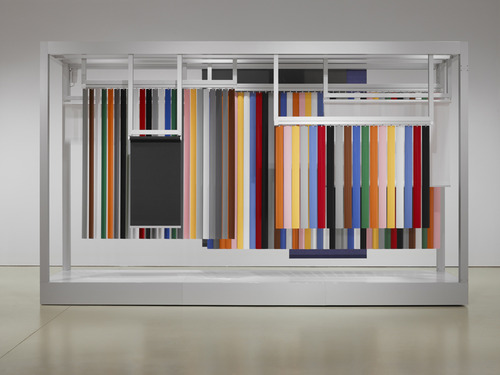|
*Organized and circulated by the Art Gallery of Hamilton and The Robert
McLaughlin Gallery in collaboration with the Southern Alberta Art Gallery and the Art Gallery of Windsor, The Collaborationists is curated by Linda Jansma and Melissa Bennett. The collaborationists are Jennifer Marman and Daniel Borins, and they are collaborating with the pantheon of modern artists, in a continuation of their cheeky innovative work that intersects modernist references with current technologies. Their interactive, kinetic installation Pavilion of the Blind has been travelling across Canada and is scheduled for the Scottsdale Museum of Contemporary Art (SMOCA) in May 2015. Truly twenty-first century artists, they graduated from the Ontario College of Art and Design in 2001 and since then have had significant impact on Canadian art both at home and south of the border. Nuit Blanche darlings of 2007, their Event Horizon set extraterrestrial images from popular culture within religious symbolism, with ET and Yoda as centrepieces. Following this was a trajectory into a dynamic career, fueled through an ambitious production schedule that has seen them mounting installations at the National Gallery of Canada, Albright-Knox Gallery in Buffalo, as well as venues in New York, Louisville, Miami, and Basel. The current exhibition embodies both minimalist geometric abstraction and hilarious parody. Appealing to toddlers and sophisticates alike, the artists have created a cleverly esoteric crowd pleaser. The fun part is in the motion-sensitive installation that dominated The Robert McLaughlin Gallery's largest gallery space, so enormous that gallery staff had to walk the piece through the building since it was too large for their loading dock. Titled Pavilion of the Blind, it calls up the window blinds section in a big box store. As one approaches, the brightly coloured stripes lift and lower, reforming mechanically. Unbridled childish delight bubbles forth as the blinds go up and down as viewers move about, reconfiguring the colour sets to create seemingly endless arrays. This central piece in the exhibit is accompanied by several fine paintings that recall the minimalist abstractions of high modernism by artists such as Guido Molinari or perhaps the colour studies of Josef Albers. Bands of colour not only connect to the present as bar codes and a much-advertised world of window fashions, but could stand alone as examples of high art from an earlier decade. Carrying the trope of industry further, one can think about Marcel Duchamp's Nude Descending a Staircase, which was derogatorily called "explosion in a shingle factory" by its critics. In contrast, Pavilion of the Blind, in its reference to a ubiquitous material world, exhibits a deliberate and controlled restraint where hard edge paintings as well as mechanically derived ones do not invite a commensurate level of abandon. Control is on the agenda. Within the context of kinetic work the installation resides in a more ambiguous dimension. The exhibition reads as both an homage and a playful satire that in a larger sense questions the nature and value of aesthetics. But beyond an esoteric discussion of formal issues lies a darker current. As blinds rise and fall the question of surveillance emerges, and while it is lightly touched upon by the artists, the suggestion of the gaze, of spying, of a continual sense of being watched, even if it's only by multi-national retailers, all comes to the forefront. Admittedly, the exhibition has many layers and goes in many directions. Whether this creates a blurring of focus and intent, or interesting complexity, is for viewers to decide.
0 Comments
|
Archives
February 2024
|
Margaret Rodgers | Canada


 RSS Feed
RSS Feed